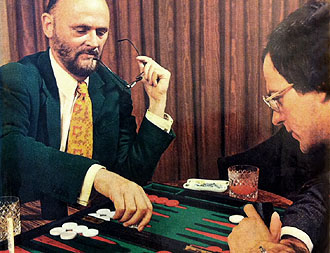|
| Magriel's NYT Columns |

Robert Brinig (right) playing with Terence Reese.
(Photo from the book they authored together.) The high point in the backgammon year was the recently completed Philip Morris International European Backgammon Championship at Monte Carlo. It drew the strongest competitors from all over the world, including former French tennis star Jean-Noël Grinda.
Known as France’s leading backgammon player, he proved his ability once again. After defeating R. Maisel in the semifinals, he overwhelmed Robert Brinig 25–12 in the finals to take the championship.
Additional results: Brinig defeated Hermes Michaledes in the other semifinal match. Charles (Chuck) Papazian took the first consolation, Alan Lorenz the second, and Philip Martyn the last-chance competition.
An unusual situation occurred near the beginning of Grinda’s semifinal match with Maisel. It provoked heated discussion among the scores of spectators viewing the match on closed-circuit television.
Earlier in the game Maisel (White) was hit by Grinda (Black) during the bearoff. Grinda then skillfully contrived to hit a second man, but Maisel established Grinda’s 2-point. In the diagrammed position, Grinda rolled a 4-1. He was now faced with a nonstandard endgame situation in which his opponent had 12 men off and all three remaining men in play
|
| Black to play 4-1. |
The obvious move would be to hit White’s man on the 23-point, sending the third man back. Suppose Black now completely contains all of White’s men in his home board until he is ready to begin bearing off. Will this strategy lead Black to a decisive winning position? Unfortunately, it will not. Experience has proved that a victory from such a position, in which the opponent holds the 2-point, is highly problematical. Despite White’s three men back, he will still win the race a good percentage of the time.
The unfamiliar nature of the position disguises the fact that Black has a superior game plan. Black’s objective must be to close White out — not contain him. That is, Black needs to close all the points in his home board, keeping White on the bar. Of course, it is impossible to do this while White owns the 2-point. Black must lure White off his anchor. If White is forced to run out, each of his men will be isolated and defenseless. Then Black can attack, easily close White out, and later pick up (hit) a third man. In this case, the bearoff would pose no problem for Black — he could be confident of victory.
The correct play is 7/6, 7/3, breaking the bar-point and waiting for White to run. With this play, Black brings in builders to make the 2-point later on. More importantly, this forces White off his anchor with 5’s, in additional to 6’s. Black needn’t worry about the blot left on the bar-point; in fact, he would welcome being hit by a 5 on White’s way out. This would give him an extra shot at the man in White’s inner board.
The winning strategy requires dislodging White from his anchor. The obvious play, hitting immediately, would accomplish the exact opposite of this. If hit now, White, instead of breaking the 2-point, would use up many subsequent rolls reentering and then bringing this man around. In unusual positions such as this one, it is critical to formulate an overall strategy. The first play one sees may actually be counterproductive.
In the game at Monte Carlo, Grinda at first overlooked the proper strategy and hit Brinig’s blot. Fortunately, though, he had a second opportunity, many rolls later, in a similar position, made the right play then, and won the game.
Rollout
 Tom Keith 2013 |
|
Money play White owns 2-cube Black rolls 4-1 1296 games with VR Checker play: 2-ply Cube play: 3-ply Red |
| 4-1: | Game | G | BG | Equity | ||||
| 1 | 7/6, 7/3 |
W L |
.7054 .2946 |
.0000 .0404 |
.0000 .0069 | +0.2802 |

| (a) |
| 2 | 18/14, 7/6 |
W L |
.7020 .2980 |
.0000 .0378 |
.0000 .0064 | +0.2798 | (0.0004) | |
| 15 | 24/23*/19 |
W L |
.5598 .4402 |
.0000 .0138 |
.0000 .0019 | −0.0295 | (0.3097) | Hit |

|
|

